(408) 448-1328
Spring days in the garden are made richer by tending thoughtfully to the earth that supports them, and us.
Earth Month is the perfect opportunity to re-examine our relationships with the land around us and the ecosystems we are a part of. As we move into May, planting native is a great way to continue the momentum of our eco-journey into the rest of the year. When you plant native, you give back to the earth, support local wildlife, and add natural beauty to your landscape!

Asclepias speciosa - Showy Milkweed Support endangered monarch butterflies with Asclepias speciosa (shown here) and Asclepias fasciluraris (Narrowleaf Milkweed), both available in #01 pot size.

Eschscholzia ‘Buttermilk’ - California Poppy Fill your yard with our state plant - California poppy! This one, selected for the garden, is a beautiful pale yellow. Attracts bees. Shown in 4” size. Other varieties available in 4” and #01 size.

Heterotheca sissiliflora ‘San Bruno Mountain’ - California Golden Aster Mat-forming fuzzy foliage with bright yellow flowers from summer to fall that attract bees and butterflies. Great for coastal or rock gardens. Native cultivar. Shown in #01 pot size.

Iris douglasiana - Douglas Iris Plant this native wildflower - a host plant for native moths - in your home garden! Flowers in blue, pink, purple, white, and yellow. Shown in #01 size; other varieties available in quart size.
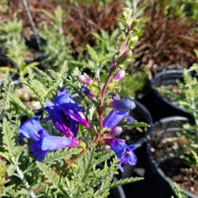
Penstemon heterophyllus ‘Electric Blue’ - Beardtongue Native Penstemons come in gorgeous shades of purple, red, and white and are hummingbird magnets! Many varieties available. Shown in #01 size; some also available in 4” pot.

Sisyrinchium bellum - Blue-Eyed Grass Actually a perennial herb, Blue-eyed “grass” is common to woodland areas. Self-sowing. Flowers January–July; then dormant. So-called for its pretty, small, blue-purple flowers and grasslike leaves. Shown in #01 size; Sisyrinchium bellum ‘Arroyo de la Cruz’ also available.

Achillea millefolium - Common Yarrow Native yarrow is a host plant for native butterflies and moths and attracts other native insects. It spreads by rhizomes underground. Shown in #01 pot.
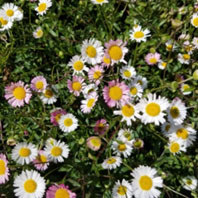
Erigeron karvinskianus - Santa Barbara Daisy Native bees, flies, and wasps enjoy the pretty little pink and white flowers, which bloom nearly year-round. Use as a trailing groundcover. Shown in #01 pot; also available in 4” size.
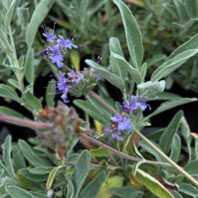
Salvia leucophylla x sonomensis - ‘Bee’s Bliss’ Sage Bees and hummingbirds love the beautiful purple flowers of this low-growing, 2’x8’ native sage. Perfect for habitats or draping over walls or rocks. Available in #01 and #05 size.
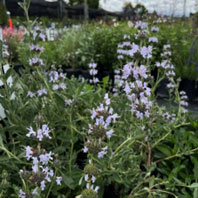
Salvia mellifera ‘Terra Seca / Green Carpet’ - Black Sage If the wonderful fragrance of this 2’ x 5’ Black Sage isn’t enough, the gorgeous whorled flowers are a nectar source for many native butterflies and also attract hummingbirds! Ideal for making sage honey. Available in #01 and #05 pot size.
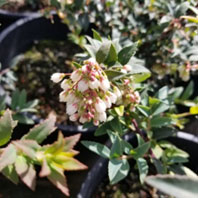
Vaccinium ovatum hybrid ‘Indian Wanderer’ - Evergreen Huckleberry Delicate clusters of little white flowers against dark green leaves and red stems. Forms a small thicket. Attracts bees, butterflies and hummingbirds; berries are a food source for native animals. Shown in #03 pot size - currently sold out.

Heuchera maxima - Island Alum Root This winter-flowering herbaceous perennial has large, glossy green leaves that form a low mat. Great for coastal sun or shade gardens or inland shade gardens. Hummingbirds love the flowers! Shown in #01 size.
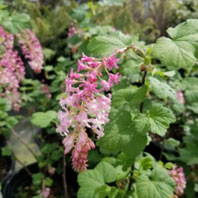
Ribes sanguineum var. glucosum ‘Spring Showers’ - Flowering Currant Showy pink spring flowers attract hummingbirds! Aromatic, fuzzy leaves are attractive year-round. A native cultivar; host plant for native butterflies. Shown in #05 pot; also available in #01 size.

Polystichum munitum - Western Swordfern A robust native fern that grows up to 6’x5’ and is prized for its foliage. Host plant for native butterflies and moths. Shown in #05 pot.

Carpenteria californica ‘Elizabeth’ - Bush Anemone Beautiful fragrant white flowers adorn this upright native shrub and attract butterflies. Perfect for a pollinator garden! Shown in #05 size; also available in #15.
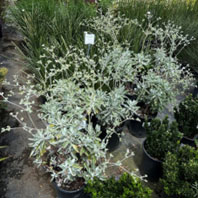
Eriogonum giganteum - St. Catherine’s Lace A host plant for native butterflies and moths, St. Catherine’s lace also supports a wide variety of other wildlife. Features sage-like foliage with clustered, lacy flowers from spring to fall. Shown in #05 pot size; also available in #01.

Lavatera (Malva) ‘Supernova Starhawk’ - Tree Mallow Purple-veined nodding flowers adorn this bushy shrub, a hybrid of our native Lavatera (Malva) assurgentiflora. Attracts butterflies and can be used as a windbreak. Shown in #15 size; also available in #05 size.
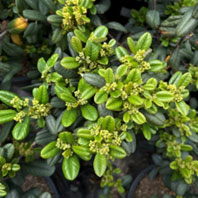
Rhamnus californica ‘Leatherleaf’ - Coffeeberry A lovely spring-blooming rounded shrub with dark, leathery foliage and small green flowers that attract birds and later, berries that attract wildlife. A nursery cultivar. Shown in #05 pot size; also available in #01 and #15.
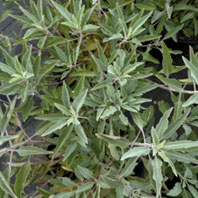
Salvia apiana ‘Compacta’ - White Sage A fragrant host plant for native butterflies and moths that also supports bees, birds, and hummingbirds. Tall white flower stalks in spring and summer attract pollinators. #01 and #05 pot size; also available in full size/non-compact form.

Salvia clevelandii ‘Winifred Gilman’ - Blue Sage A cultivar of Cleveland Sage, Winifred is selected for the garden. Both its foliage and its spring and autumn blooming flowers have a wonderful fragrance. Shown in #05 pot size.

Spheralcea ambigua - Desert Globe Mallow A stunning color contrast - bright orange to pink flowers against small gray leaves - that also supports native butterflies, bees, and birds. Shown in #05 pot size.
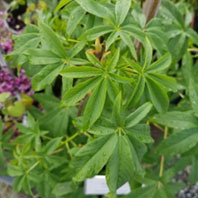
Aesculus californica - California Buckeye Small tree with pretty green foliage and upright, creamy white flowers in spring–summer that attract insects and butterflies. Nectar source for migrant butterflies. Toxic fruits drop in fall. Shown in #05 pot; also available in #15 and #24, single and multi-trunk.

Cercis occidentalis - Claremont Western Redbud Vibrant clusters of dark pink flowers in late winter/early spring turn to heart-shaped blue-green leaves this time of year. Host to butterflies and moths and supports birds as well. Shown in #05 pot; other varieties available larger.
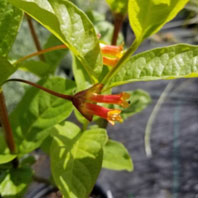
Lonicera involucrata - Twinberry Honeysuckle A host plant for many native butterflies and moths that also attracts hummingbirds and bees. Can be grown as a vine on a trellis or espalier. Shown in #01 pot size.

Vitis californica x vinifera ‘Roger’s Red’ - California Grape Native grape perfect for trellises, arbors, or as groundcover that also supports native butterflies and birds. Red foliage in autumn with sweet, edible, seedy fruit. Shown in #05 pot size.

Muhlenbergia rigens - Deer Grass A popular native bunchgrass. Produces tall flower spikes in spring and summer. Fall seeds attract birds, who also use it for nesting and cover. Attractive as specimen planting or en masse as bank cover. Shown in #01 pot size; also available in #05 size.

Calamagrostis nutkaensis x foliosa ‘Little Nootka’ - Reed Grass A shorter, denser reed grass with arching wheat-colored flower plumes. A cross between two other reed grasses, discovered at Cal Flora Nursery. Shown in #01 pot size.

Festuca californica - California Fescue A long-leaved native grass that is great to use for renaturalizing areas taken over by non-native grass. Host plant for moths and butterflies. Shown in #01 size; also available in #05 size.